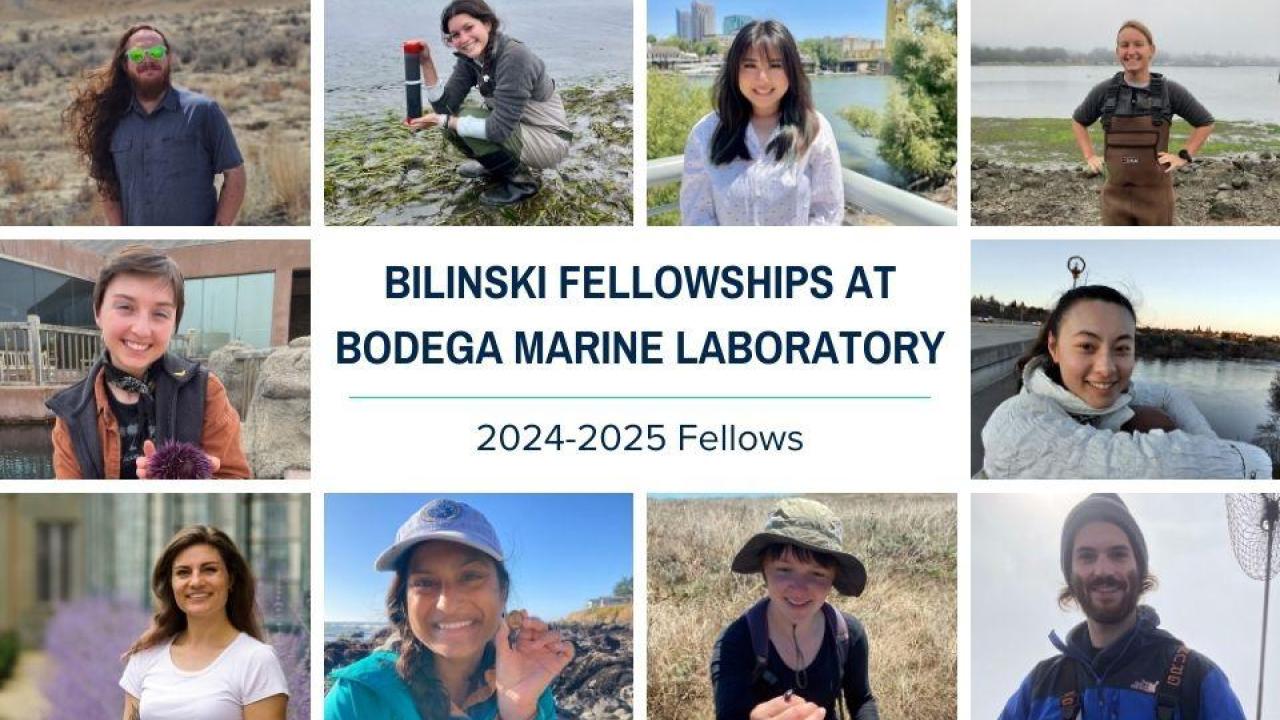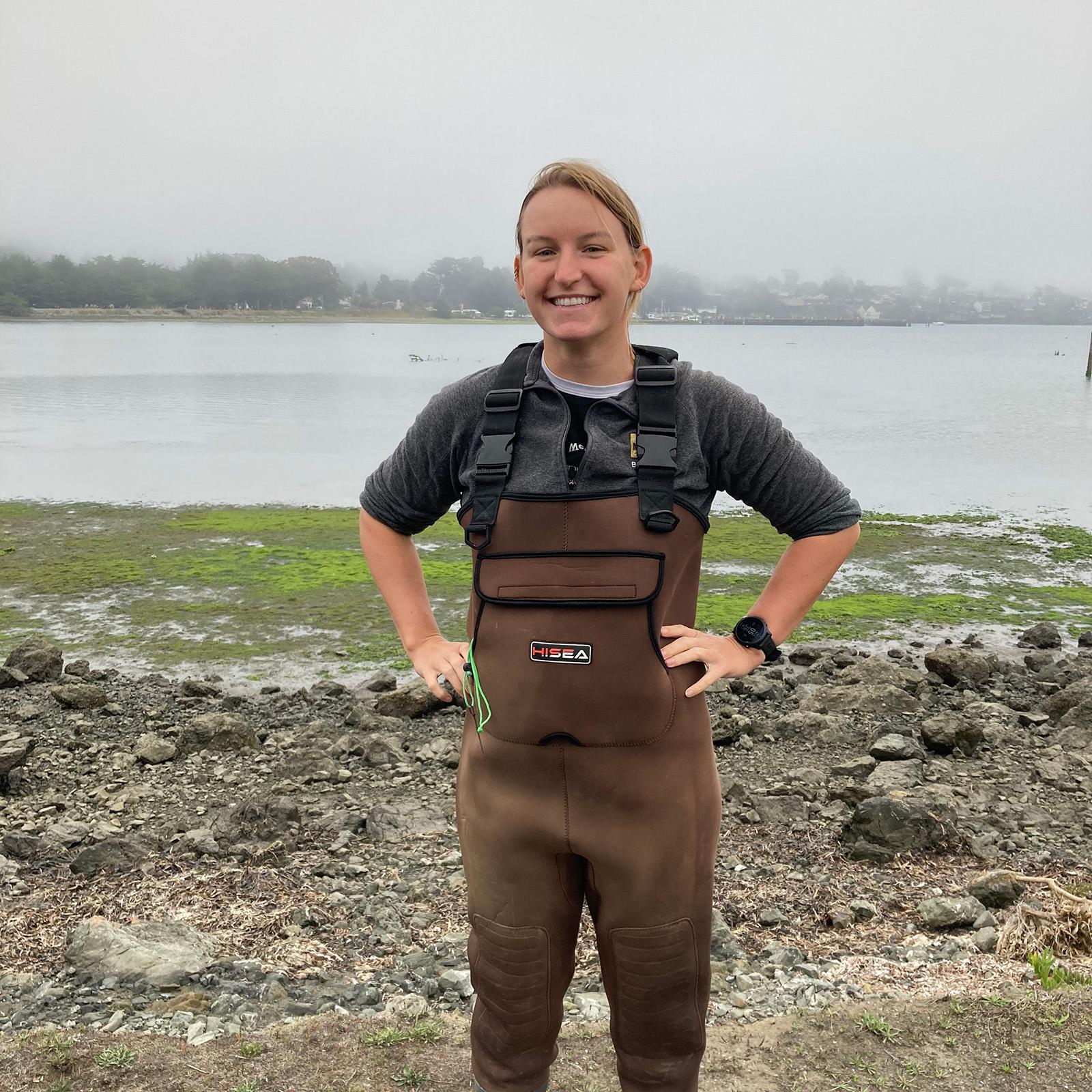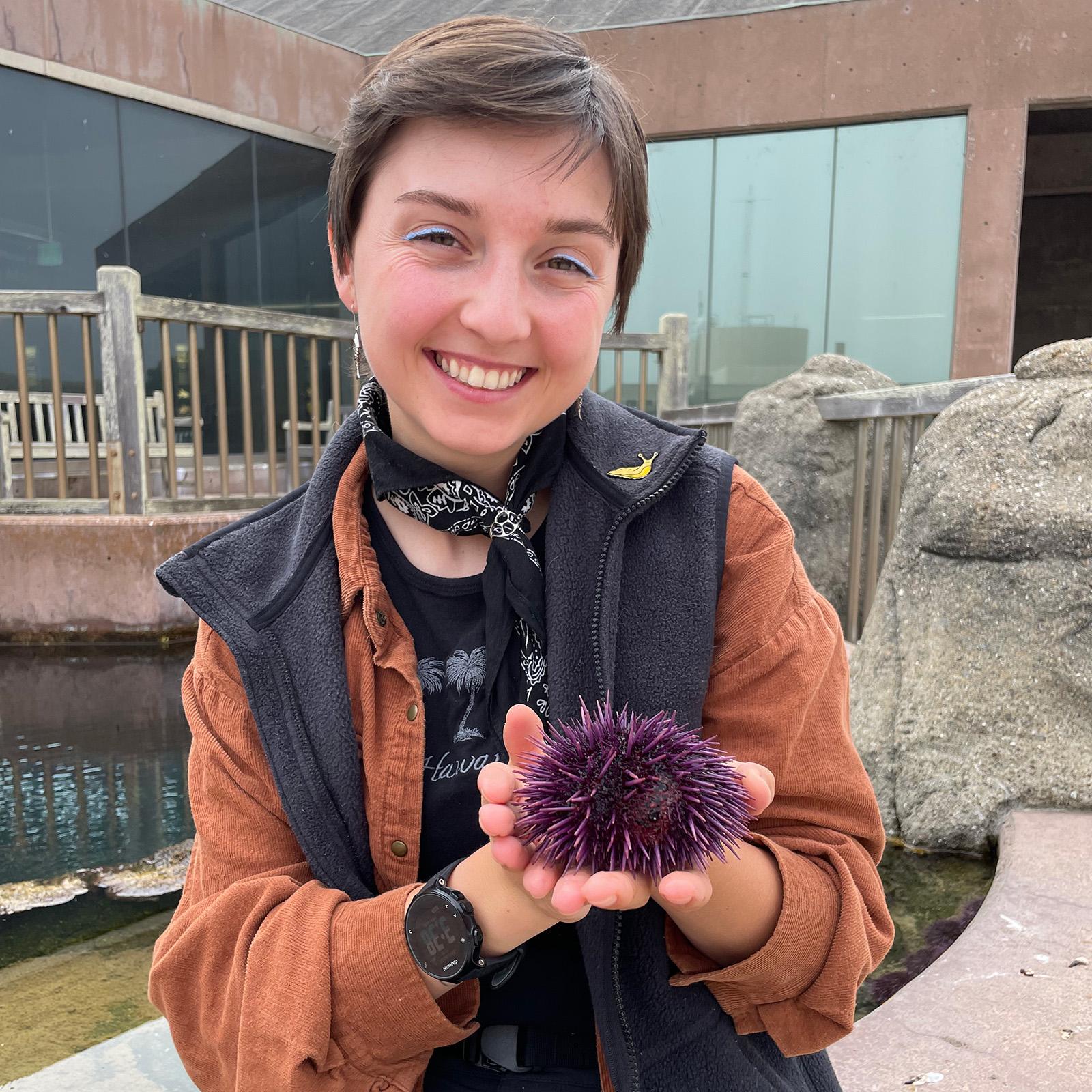
Announcing the Recipients of the UC Davis Bilinski Fellowship at Bodega Marine Laboratory for 2024-25
The Coastal and Marine Science Institute is pleased to announce the ten recipients of the UC Davis Bilinski fellowship at Bodega Marine Laboratory for 2024-2025. Russell J. and Dorothy S. Bilinski’s life goal was to be “independent and challenged intellectually.” They strongly valued self-sufficiency, a sense of ambition, and above all, responsibility. Their legacy continues in their nonprofit corporate foundation that provides fellowship funds for post-secondary education for students who have demonstrated and will maintain both the highest academic achievement and good moral character.
Bilinski fellowships are awarded to outstanding doctoral students whose selected projects, based at the UC Davis Bodega Marine Lab, exhibit innovation, collaboration, and are a key component of the student’s final dissertation. The awardees below successfully bridged the natural sciences, social sciences and humanities in their project proposals. As a result, recipients were each awarded $25,000 to assist with tuition, stipend, and research expenses.
Meet the Recipients:

Christopher Mulligan
Seagrasses are facing many risks ranging from climate change to diseases, and traditional methods to evaluate their health can be timely, exhausting, and expensive to carry out for long term monitoring programs, especially frequently across many sites.
The goal of Chris’ project is to show that lipid analyses of bird droppings can provide an easy and noninvasive way to assess the health of seagrass beds, by tracing the grass lipids up the food chain and ultimately onto nearby beaches. To Chris, an important part of this is designing the workflow to be streamlined for citizen scientists to carry out the field work elsewhere, such as bird watching groups.
Chris will also create an art installation that uses the technique of data physicalization, where scientific concepts and raw data are abstracted and made into a physical artform, to show interactions within a healthy seagrass ecosystem compared to a collapsed ecosystem. Chris’ PhD thesis studies how lipids can be used to learn more about both modern and deep-time animal ecology, by combining many techniques like metagenomics and organic geochemistry.

Elisabeth Sellinger
Elisabeth studies carbon sequestration and storage in restored seagrass ecosystems along the California coast. She is working with Greater Farallones and Monterey Bay National Marine Sanctuary to co-create research questions and produce a video that explores seagrass habitats and their potential for climate change mitigation.
By bringing together diverse perspectives and expertise, this project offers an inclusive platform for local communities and K-12 learners to explore the intricate relationships within marine ecosystems. This collaborative endeavor will foster a deeper understanding of the vital role of seagrass meadows in carbon storage, emphasizing the importance of equitable access to knowledge and resources. Through this interdisciplinary approach, the video will inspire collective action towards marine conservation and foster a sense of stewardship for coastal environments.

Gabby Yang
As environmental impacts become increasingly uncertain, understanding how science is applied to policy decisions is crucial to forming effective management strategies.
Gabby’s project provides a unique insight into the role of science in restoration management by using social network data from a California kelp forest restoration survey to facilitate interviews at BML and surrounding communities. The interviews will determine how individuals navigate the intersection of multiple roles and how their responsibilities allow them to respond to rapid environmental challenges. This includes community members, policymakers, restoration managers, and scientists. She hopes her research will facilitate more effective responses to emerging environmental challenges.

Katie Erickson
Katie’s dissertation research is centered on understanding the ecological and evolutionary genomics of eelgrass. She is interested in when and how eelgrass plants and their genes have arrived at locations across the species’s range.
For their Bilinski project, Katie is collaborating with artists Anna Goetter, Sitoë Thiam and Erica Goodwin to explore how and when natural and unnatural elements are introduced to the Bodega Bay local environment. Through the lens of fashion, the collaborators aim to chronicle and highlight arrivals to the Bodega environment by creating a collection of high-fashion looks made from and inspired by found materials. A showcase of their completed work will be presented at Bodega Marine Lab and a guide of the textile manipulation methods they use will be distributed in the form of a zine.

Maddie Armstrong
Maddie’s research focuses on the evolutionary implications of urban pollution and how these novel stressors can impact the development and evolution of marine invertebrates, specifically Pacific purple sea urchins. Purple urchins are a critically important native species in California kelp forest ecosystems as a dominant consumer of kelp.
For her Bilinski Fellowship project, Maddie will host a interdisciplinary workshop for the Bodega Marine Lab and surrounding Bodega Bay community with natural dye artist Margaret Seelie, founder of Seelie Studio. Margaret uses natural dyes to inspire sustainable art practices and runs several natural dye workshops across California, including a workshop using purple sea urchin spines. Through this interdisciplinary workshop held at BML, Maddie will show the various ways people can interact with purple urchins, highlight the importance of this species in kelp forest ecosystems, and hopefully inspire an appreciation of purple sea urchins as a useful system for both scientific research and for sustainable art.

Mei Blundell
Mei Blundell will work with Max Gibson, a PhD student in the Department of Music, to create a musical composition inspired by the concept of temporal buffering in kelp population dynamics. She will then work with dancers to set choreography to the original music.
Through this project, she hopes to visually and sonically represent results from her dissertation chapter exploring how kelp life stages contribute to population resilience to marine heatwaves. Folks who are interested can expect performances of this project in Spring 2025.

Mikhaila Redovian
Mikhaila Redovian will be working on a project that draws on her combined background in literary studies and geology. At Bodega Bay, she will be collating and studying the stories that scientists tell about their sample sites.
Mikhaila’s primary interest is in the way that we think about, talk about, and live with places that resist observation and evade human control. How do we consider or reconsider our place in our world, especially when it is unruly, frustrating, or even hostile to us? This project will seek responses to these questions as a way of interrogating how humans use narrative to understand their relationships with the natural world.

Shreya Banerjee
Shreya Banerjee is a PhD student in Population Biology and she is studying differences in thermal tolerance between two cryptic species of ribbed limpets. The occurrence of cryptic speciation in marine organisms with pelagic larval dispersal poses a scientific puzzle. How can two apparently identical species occupy the same habitat without one outcompeting the other?
She will utilize this exciting mystery as a learning opportunity for high school students by collaborating with Jasmine Daragahi, a biology teacher at Natomas Pacific Pathways Prep High School (NP3HS), to conduct a class research project with 85 ninth grade biology students. This experience-based learning opportunity will include exploring the natural history of tidepools at the Bodega Marine Reserve (BMR), hypothesis testing, molecular biology techniques, and data analysis and interpretation in the form of three classroom visits and a field trip to BML.

Tracie Hayes
Tracie has spent much of her dissertation researching the burying beetles out at the Bodega Marine Reserve, where she has been interested in how moisture, such as that from coastal summertime fog, affects survival and reproduction. Beyond her scientific research, she believes the burying beetle life cycle and the process of doing ecology lend themselves to creative endeavors, such as art-making and storytelling.
For Tracie's Bilinski project, she is carrying out a field experiment that will involve: (1) scientific data collection on the effects of moisture on burying beetle reproductive timing and success, and (2) an ideal set-up for videographers from KQED’s Deep Look to film burying beetle parents and offspring at multiple stages of the reproductive process. The Deep Look team will use the footage they collect to produce a short-form video with public appeal.

Zeke Spooner
With microplastics pollution in the ocean continuously increasing, Zeke is concerned that these particles are infiltrating California's coastal benthic communities. He will investigate this by determining bioaccumulation of microplastics and microplastic leachates in California rockfish, which are important benthic predators.
Knowing the importance of rockfish to California's coastal fishing communities, Zeke has developed a community engagement plan to spread awareness of the microplastics problem to locals. This plan includes beach waste assessments with the community and the facilitation of citizen science-fueled field projects on microplastics.
